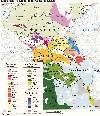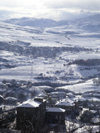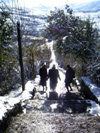 The
Talysh number about 200.000, of which 130.000 live in the south-east of
the Republic of Azerbaijan, near the Iranian border in and around Lenkoran,
Astara
and Lerik. The rest of the Talysh live
across the border in the Iranian province of Gilan, in a long strip of
territory along the Caspian coast, from Astara to the Rasht area. They
occupy a land of sharp contrasts, ranging from the high, forested Talysh
Mountains, to the subtropical coastal land along the Caspian Sea. Often
the Talysh populated area is referred as Talyshtan.
The
Talysh number about 200.000, of which 130.000 live in the south-east of
the Republic of Azerbaijan, near the Iranian border in and around Lenkoran,
Astara
and Lerik. The rest of the Talysh live
across the border in the Iranian province of Gilan, in a long strip of
territory along the Caspian coast, from Astara to the Rasht area. They
occupy a land of sharp contrasts, ranging from the high, forested Talysh
Mountains, to the subtropical coastal land along the Caspian Sea. Often
the Talysh populated area is referred as Talyshtan.
The Talysh refer to themselves as 'Talushon', and speak an Indo-Iranian language that is also called Talysh. Although all of the Talysh groups speak their native language, most are also bilingual, speaking Azeri, Russian or Farsi. The Talysh have lived in the southwest Caspian Sea region for thousands of years. They came under Turkish influence during the Middle Ages, but established their own khanate in the 17th century, with capital first in Astara and later in Lenkoran.
 In
the early 19th century the Talysh of present day Azerbaijan fell under
Russian control, which continued until 1991, when Azerbaijan succeeded
from the Soviet Union.
In
the early 19th century the Talysh of present day Azerbaijan fell under
Russian control, which continued until 1991, when Azerbaijan succeeded
from the Soviet Union.
Today, the Talysh face the same dilemma as the Central Asian peoples as they attempt to decide whether to follow Islamic traditions of the past, or the Western culture and technology of the present.
 The
majority of the Talysh are farmers. In some areas, rice is the primary
crop; in other, wheat and barley are grown. Tea and citrus fruits are raised
in the lowlands near the Caspian Sea. Many of the Talysh living in the
lowlands cultivate fresh produce, including garlic, onions, pumpkins, melons,
peas and grapes.
The
majority of the Talysh are farmers. In some areas, rice is the primary
crop; in other, wheat and barley are grown. Tea and citrus fruits are raised
in the lowlands near the Caspian Sea. Many of the Talysh living in the
lowlands cultivate fresh produce, including garlic, onions, pumpkins, melons,
peas and grapes.
But not all Talysh are farmers, some have become skilled craftsmen. Their primary handicrafts include the production of silk, rugs, and felt. Some work with tin, make shoes, or design jewellery.
 The
Talysh living in mountainous areas typically live in flat roofed homes
built of uncut stone. Those on the coastal zone live in clay houses that
have roofs made of reeds or sedge (grass like plants with solid stems).
The homes usually have high doors reaching to the ceiling, since there
is no opening in the roof to allow smoke from the cooking fires to escape.
The traditional Talysh homes have no furniture. However, today, a growing
number of homes have adopted Western-style furnishings.
The
Talysh living in mountainous areas typically live in flat roofed homes
built of uncut stone. Those on the coastal zone live in clay houses that
have roofs made of reeds or sedge (grass like plants with solid stems).
The homes usually have high doors reaching to the ceiling, since there
is no opening in the roof to allow smoke from the cooking fires to escape.
The traditional Talysh homes have no furniture. However, today, a growing
number of homes have adopted Western-style furnishings.
Talysh women once wore traditional Muslim clothing, which consisted of veils over their faces and long robes that completely covered their bodies. Today, may Talysh women, especially those in Azerbaijan, have abandoned the customary outfit and wear Western-style clothing.
 Although
Islamic law permits men to have as many as four wives, most Talysh men
take only one wife. Boys usually marry while they are between the ages
of 15 and 20; whereas, girls usually wed while they are between the ages
of 12 and 16. The groom's family is required to pay a bride price, or 'kebin',
which consists of money and items such as carpets and utensils. To avoid
paying the kebin, a young man will sometimes "kidnap" the prospective bride,
taking her as wife.
Although
Islamic law permits men to have as many as four wives, most Talysh men
take only one wife. Boys usually marry while they are between the ages
of 15 and 20; whereas, girls usually wed while they are between the ages
of 12 and 16. The groom's family is required to pay a bride price, or 'kebin',
which consists of money and items such as carpets and utensils. To avoid
paying the kebin, a young man will sometimes "kidnap" the prospective bride,
taking her as wife.
The Talysh are Muslim, primarily of the Shia branch. Some remnants of their pre-Islamic religion remain. For example they have a reverence for trees and groves, and trees form some of their most sacred sites. They also believe in the presence of both good and evil spirits, with the most dangerous spirit being 'Alazhan', the 'Red Woman'. Alazhan is believed to attack women during childbirth as well as new-born babies.
 The
main organisation that represents the Talysh people is the Talysh National
Movement. The objective of the Talysh National Movement is to work via
the United Nations to realize its mission of self-determination and get
recognition of the Talysh nation. The Talysh National Movement is an emancipatory
organization created by the Talysh people and is the heir of the Talysh
political movements of 1993, in particular the Talysh-Mughan
Autonomous Republic - Talyshstan.
The
main organisation that represents the Talysh people is the Talysh National
Movement. The objective of the Talysh National Movement is to work via
the United Nations to realize its mission of self-determination and get
recognition of the Talysh nation. The Talysh National Movement is an emancipatory
organization created by the Talysh people and is the heir of the Talysh
political movements of 1993, in particular the Talysh-Mughan
Autonomous Republic - Talyshstan.
Talysh Talish Tallish
sources: multimap, bethany